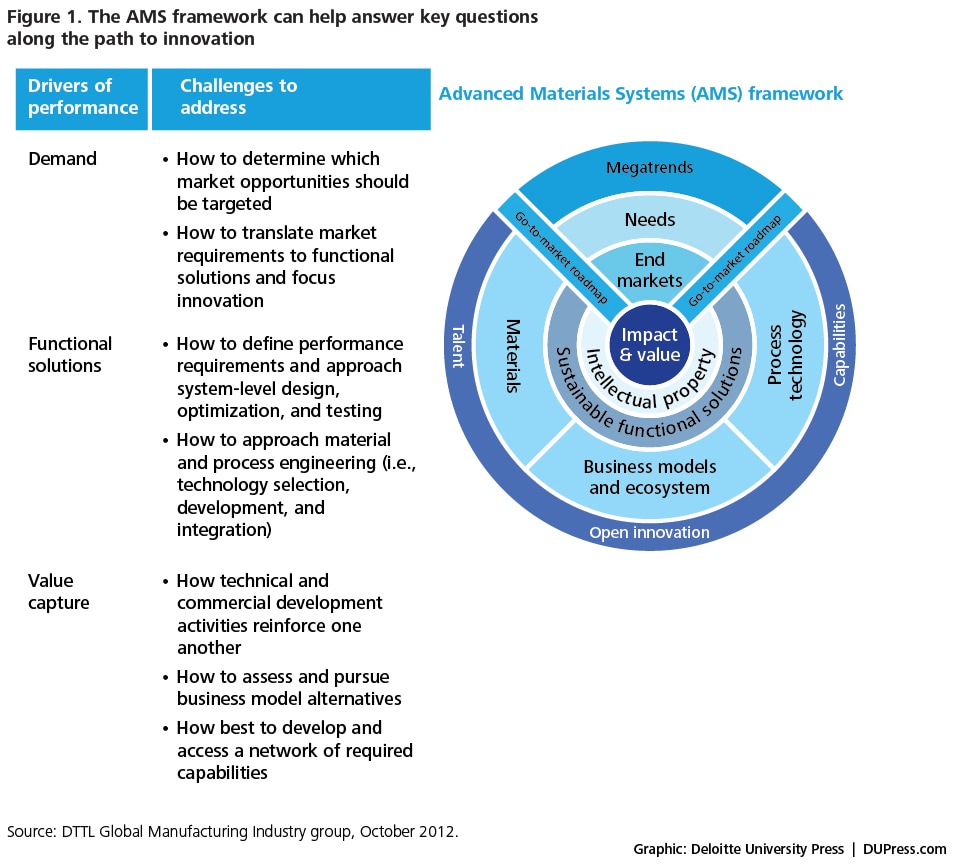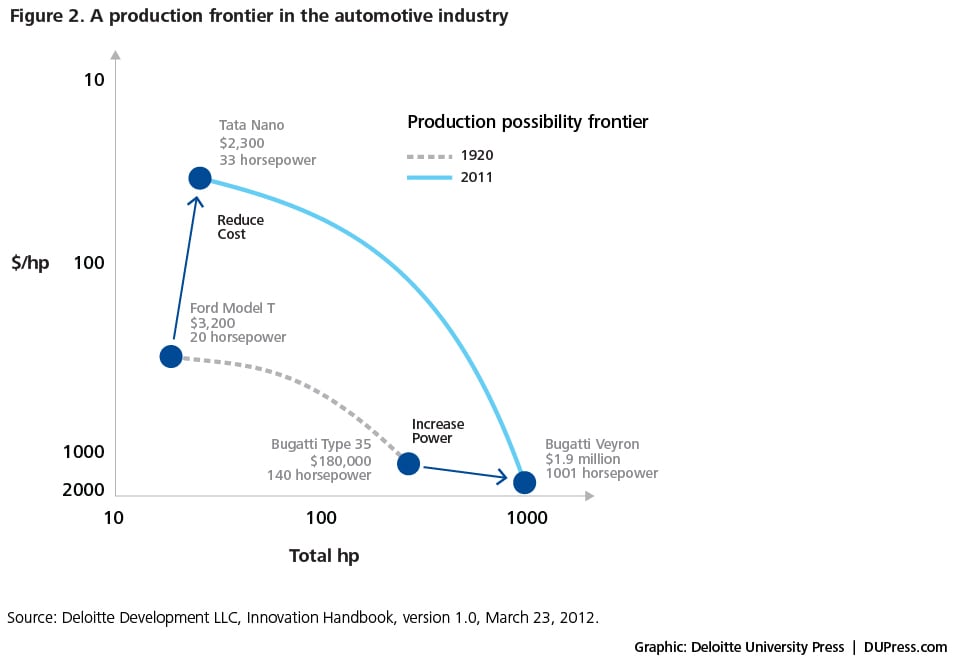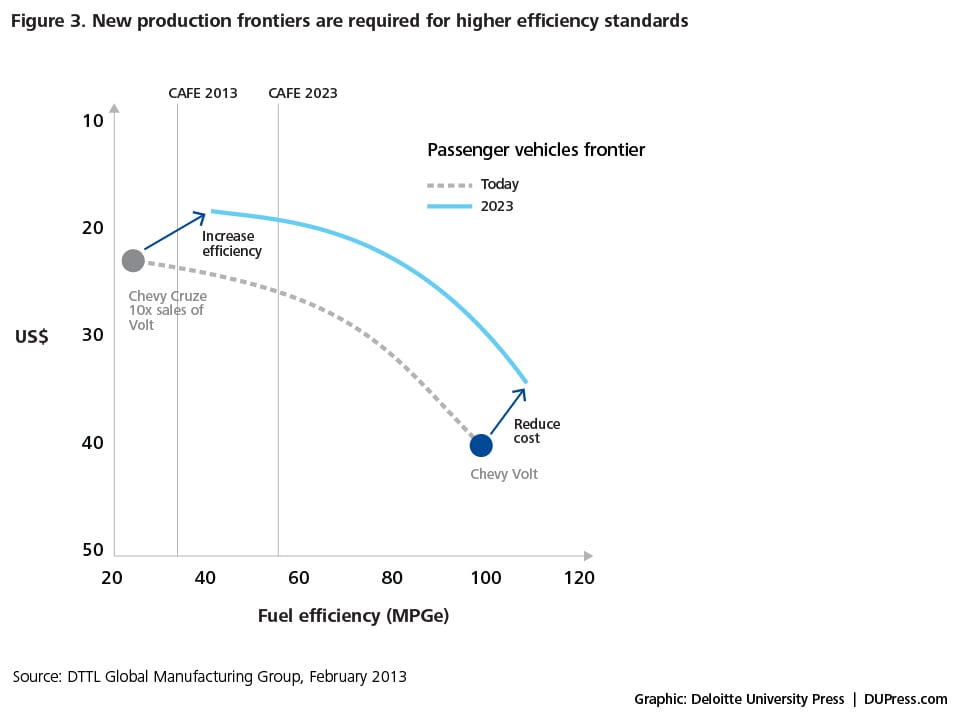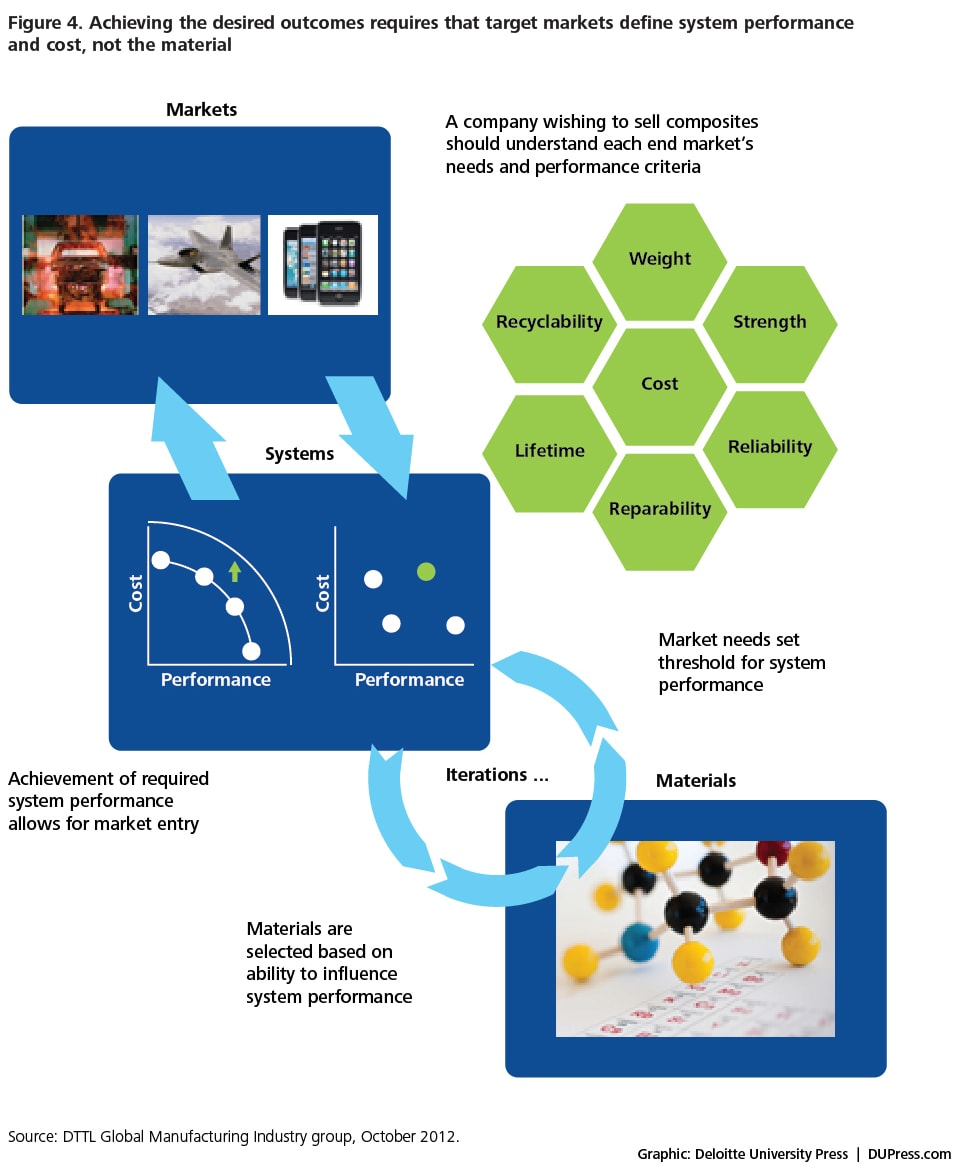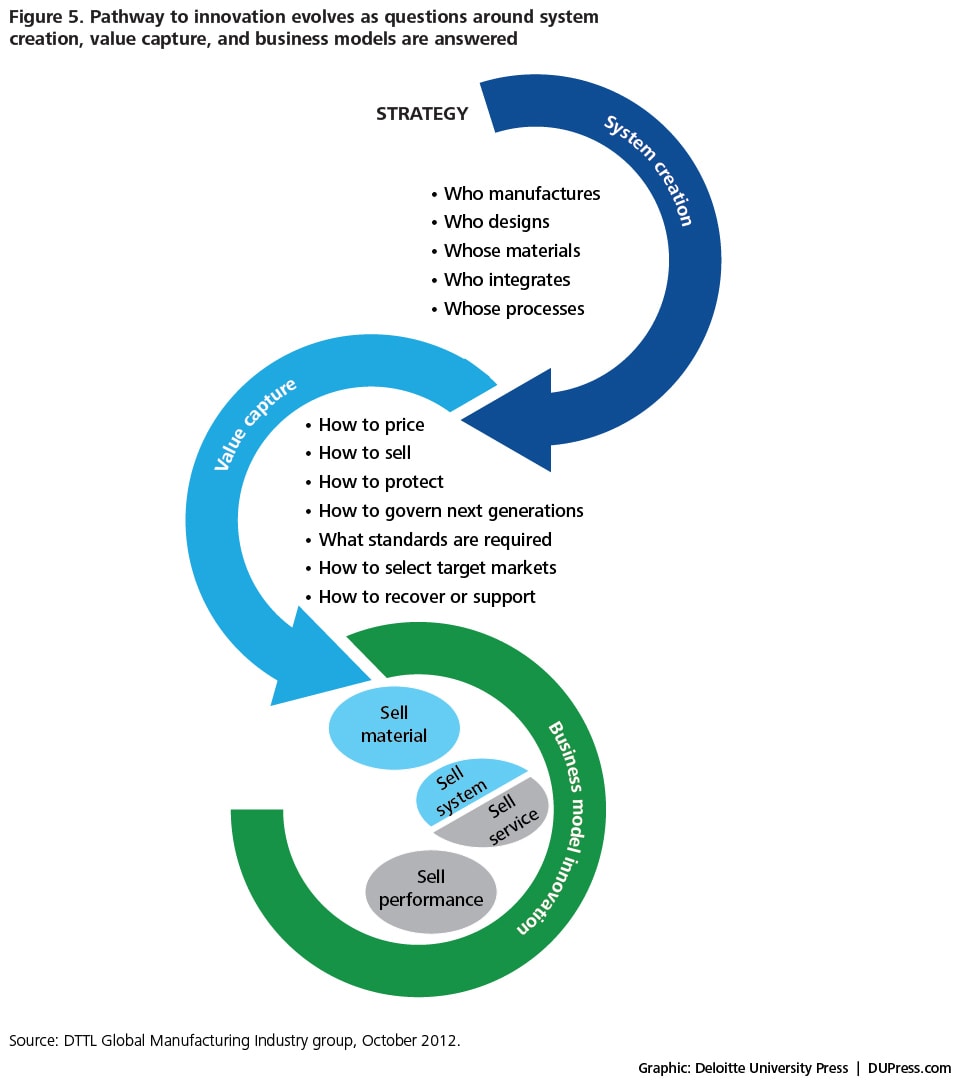Driving innovation: Advanced Materials Systems has been saved

Driving innovation: Advanced Materials Systems Part of a Deloitte series on innovation
29 March 2013
- Duane Dickson, Tom Aldred, Jeff Carbeck
An Advanced Materials Systems approach can help guide manufacturers beyond the frontier of inventing new molecules and materials into the realm of functional solutions to drive growth and innovation.
 Abstract
Abstract
Recently the Deloitte Touche Tohmatsu Limited (DTTL) Global Manufacturing Industry group published a report on Advanced Materials Systems, defined as specific combinations of materials, process technologies, partnerships, and business models that together, through system-level engineering, help create and capture value by addressing global unmet needs and wants.1
The Advanced Materials Systems framework (see sidebar below, Advanced Materials Systems (AMS): Key concepts and terms) provides insights into innovation and strategies for the effective and efficient development and commercialization of products and technologies. The purpose of this monograph is to focus on the dimension of innovation. Specifically, it describes how Advanced Materials Systems enable innovation by breaking existing trade-offs between the cost and performance of functional solutions enabled by materials technologies. In this way, Advanced Materials Systems can expand the realm of the possible to create significant value in the marketplace.
Advanced Materials Systems can expand the realm of the possible to create significant value in the marketplace.
A brief introduction to Advanced Materials Systems
Challenges associated with traditional business models of selling materials by volume have become increasingly apparent in overall industry performance over the last two decades. Increasing commoditization and competition, driven by a large and growing portfolio of global players, are putting significant pressure on companies to identify new sources of value to drive growth. At the same time, many companies have been struggling with innovation and often have to rely on other approaches to achieve their growth objectives. As a result, many sectors of the manufacturing industry have seen significant rates of erosion in value creation over this same period of time,2 and many companies now realize that new approaches to value creation will be necessary for success in the future. Meanwhile, industries that are enabled by materials are particularly well poised to capture value in current global markets through the development of new functional solutions to address global unmet wants and needs.
As defined in The Innovator’s Manifesto: Deliberate Disruption for Transformational Growth, an innovation is “any combination of activities or technologies that breaks existing performance trade-offs in the attainment of an outcome in a manner that expands the realm of the possible.”3DTTL’s Global Manufacturing Industry group’s Advanced Materials Systems (AMS) framework provides a new approach for companies to target these opportunities for innovation and invigorate value creation (see figure 1). The approach urges companies to move beyond the frontier of invention of new molecules and materials into the realm of functional solutions as a new source of growth and innovation.
Achieving the desired outcomes/results, however, will require additional and different types of capabilities and approaches beyond those required for the invention of new materials. For example, system-level design and engineering will be a core capability necessary to leverage combinations of both new and existing materials and process technologies. In addition, new business models, together with new approaches to partnerships and collaborations that extend well beyond current concepts of “open innovation,” will likely be essential to create and grow new businesses based on functional solutions. The AMS concept is therefore a call to action for players in the AMS ecosystem to rethink conventional strategies and approaches for creating innovation and growth.
Advanced Materials Systems (AMS): Key concepts and terms
Functional solutions: In this context, the term “functional solutions” refers to physical systems enabled by the specific performance properties of materials, classified either conventionally (for example, polymers, metals, ceramics, composites, and semiconductors) or according to newer categorizations (for example, hybrid-material systems, nanostructured materials, biobased materials, bioinspired materials, and biomimetic materials).
Advanced Materials Systems: Advanced Materials Systems are defined as unique combinations of materials, process technologies, partnerships, and business models that together, through systems-level engineering, help create and capture value by addressing large, global unmet wants and needs. A functional solution is an element of an Advanced Materials System.
The Advanced Materials Systems framework: The AMS framework was created to help guide the process of developing innovations enabled by materials and process technologies (see figure 1). In case studies of both large and small companies, the analysis has found that success in creating and capturing value through solutions enabled by materials and process technologies succeeds most often when all the elements of the framework are considered.4 The framework is not meant as a prescriptive roadmap to developing AMS. Rather, by considering each element of the framework, the critical challenges that will need to be addressed and the questions to be answered to achieve the goal of impact and value through AMS are illuminated. Some of the key questions that have arisen through work in helping clients to bring new functional solutions to market are shown in the figure. This list is not meant to be exhaustive, and many other issues and challenges will arise in a context-dependent fashion.
Materials technologies: The report Reigniting Growth walks us through the materials technologies element of the AMS framework, examining case studies of materials technologies with potential for game-changing impact on numerous industries, including:
- Stretchable electronics for flexible, ultrathin diagnostics and sensors designed to be worn on the skin like temporary tattoos, undetectable to the user, with initial applications in health care, athletics, and defense
- Bioabsorbable composites that integrate existing biopolymers into medical device solutions like resorbable stents for treating arterial disease
- Solid-state lighting that dramatically reduces energy requirements while capturing significant value based on system-level engineering and intellectual property (IP)
Other emerging materials are also discussed, including self-assembled materials, biomimetic nanocomposites, metal-organic frameworks, and ionic liquids that have the potential to create significant value in the marketplace.
Process technologies: The AMS approach encourages innovation enabled by technologies for processing materials and integrating currently available materials in system-level designs. Progression from the materials focus of the AMS framework (see figure 1, left) to processes (see figure 1, right) is being enabled by the rise of several disruptive process advances with potential for multibillion-dollar disruptions to the market. Process technologies include, but are not limited to:
- Nanotechnology: Permits engineering of numerous classes of materials with heretofore unavailable structural and functional precision at ultrafine scales; entirely new sets of unique mechanical, optical, and electronic properties that emerge at the nanoscale expected to be enabled from existing materials for novel applications in virtually every industry
- Industrial biotechnology: Stands to be a major contributor of more cost-effective and sustainable production platforms and feedstocks in numerous manufacturing industries
- Additive manufacturing: Fabricates solid three-dimensional objects directly from digital models through depositing and “curing in place” successive layers of polymers, ceramics, or metals; distinguished from traditional subtractive machining techniques and allows production to be scaled out rather than up
A detailed description of broader perspectives on AMS can be found in the recent report by the DTTL Global Manufacturing Industry group titled Reigniting Growth: Advanced Materials Systems. The following section identifies and summarizes three areas of opportunity that are core in driving effective innovation in an evolving AMS landscape:
- A market-defined opportunity: The evolution of societies around the world has left no shortage of unmet needs and wants. These gaps, together with global market trends, point to challenges and opportunities for new functional solutions enabled by AMS. Examples include:
- Sustainable, carbon source-agnostic fuels and chemical feedstocks as alternatives to petroleum-based solutions that enable countries to gain leverage from a broader portfolio of resources
- Increased emphasis on the need for a more circular economy that requires material reuse to be engineered in at the system level of functional solutions
- Decentralized and scalable solutions to serve emerging markets
- The increasing role of reverse innovations that focus on functional solutions developed explicitly for large, growing, emerging markets5
- Value creation through material-enabled solutions: In the AMS framework, value potential lies in the capacity of existing materials to serve as building blocks for functional solutions rather than in their inherent commodity value. DTTL’s Global Manufacturing Industry group’s research has shown that solution providers create more economic value overall than material suppliers. By leveraging inventive combinations of materials and process technology from existing industry inventories, companies no longer have to rely solely on discovering new molecules to drive growth. Instead, companies can achieve breakthrough performance by focusing on selecting the appropriate materials for a particular application and manipulating, scaling, and/or incorporating them into new function solutions through process technology.
- Strategies to enhance/increase value capture with AMS: Recognizing that a focus on solutions comes with a long list of new challenges and required capabilities, approaching development in any way other than “open” would be extremely difficult. Indeed, “closed” approaches to creating innovation no longer correlate well with growth in revenue, income, or market capitalization.6 Since innovation is the outcome and not the approach, the AMS framework describes companies’ use of both external and internal ideas, technologies, and resources as an open approach to create innovation and value in the market (and not simply “open innovation”).7 This open approach encourages companies to look both inside and outside their four walls in the context of every dimension of the AMS framework. For example, companies should work from the markets backward to determine how to better understand end users’ requirements. Companies should manage a network or ecosystem of potential partners to gain access to markets as well as the skills, capabilities, technologies, and know-how to develop and commercialize new solutions. System-level design and technology development requirements are expected to usher in a new era of integration engineering. Being open in this way produces trade-offs between who creates and who captures value, and therefore requires companies to think differently about how they approach business development, IP, business models, and partnerships to leverage value capture.
The AMS concept is therefore a call to action ... to rethink conventional strategies and approaches for creating innovation and growth.
A market-defined opportunity
A brief introduction to production frontiers and innovation
A production frontier defines the current realm of the possible in terms of the trade-offs between the cost and performance of a functional solution or system. In many cases, the balance of cost versus performance is grounded in the fundamental materials and process technology utilized in the solution. Trade-offs that occur between performance and cost along the frontier represent a series of choices that consumers (as well as solution providers) make around what is more or less valuable to them to address their needs and achieve their objectives. A new functional solution that moves beyond the existing production frontier is innovation.
As an example, in the automotive industry, there are multiple dimensions of performance that are important, such as safety, comfort, fuel economy, and carbon emissions, and as a result, there are many cost/performance trade-offs that define these products. All the dimensions of performance and their associated cost constraints are relevant in a particular market, although not with equal weighting. The combination of all the trade-offs between cost and performance defines an n-dimensional hyperplane that is the production possibility frontier for that market. An expansion of any one element of the frontier is an innovation. In many of these instances, a new AMS-based innovation will be required to expand the frontier. Choosing the performance criteria that matter most to a particular market segment, then, is essential in using innovation to drive value creation.
Figure 2 depicts one example of the horsepower versus cost production frontier in the automotive industry.8 In this example, the trade-offs between horsepower and cost are illustrated from 1920 to 2011. In 1920, the trade-offs were bounded at one extreme by the Ford Model T, which cost $3,200 (in 2011 US$) and delivered 20 horsepower, and at the other extreme by the Bugatti Type 35, which cost $180,000 (in 2011 US$) and delivered 140 horsepower. These two automobiles defined the limits or extremes of the trade-offs between horsepower, with the Bugatti being the most powerful, and cost, with the Ford being the least expensive. Other automobiles made available to the market at the time fell somewhere along the curve between these two extremes.
Furthermore, figure 2 shows that over the past 90 years, innovation has occurred along the particular performance criterion of horsepower: Total power has increased while the cost of that power has decreased. The 2011 frontier is anchored by one significant example—the Tata Nano at the low-cost extreme of $2,300 and 33 horsepower and the Bugatti Veyron at the horsepower extreme of 1001 at a cost of $1.9 million. This is an example that defines the limits of the production possibility frontier (in terms of power versus cost) for automobiles in 2011; other commercial automobiles fall along the curve connecting these two extremes. This innovation over time was driven by many improvements in design, materials, process technologies, and methods of manufacturing, all of which either reduced costs or increased available horsepower.
Looking at an opportunity through an existing or potentially new productivity frontier alone is, however, insufficient. Where strategy comes into play is in the determination of where along the frontier the best opportunities for growth are, as all points on the curve will not be equally attractive. For the example in figure 2, only 30 Bugatti Veyrons were sold in 2011, while more than 70,000 Tata Nanos were sold during the same period. Of course, given the difference in pricing, the Tata’s total market value is only a little more than twice that of the Bugatti’s. Some of the largest passenger car markets lie along the curve between these two extremes. Different strategies will determine where the best positions are along the curve to create and capture value.
AMS drives innovation
Another relevant example from the automotive industry shows how AMS drives innovation by breaking trade-offs, in this case between cost and performance required by future fuel efficiency regulations. Figure 3 shows the current production frontier for passenger car fuel efficiency. The low-cost Chevrolet Cruze anchors the frontier at one extreme; with a standard gasoline internal combustion power train, it achieves fuel efficiency of 22 miles per gallon (MPGe)9 at a cost of $22,000. The Chevrolet Volt anchors the frontier at the other extreme; with a gasoline-electric hybrid power train, it achieves fuel efficiency of 100 MPGe at a cost of $40,000.10
Figure 3 also shows the corporate average fuel economy (CAFE) regulations for fuel efficiency in the United States for this class and size of vehicle, which is 37 MPGe in 2013. To achieve this overall efficiency, automakers manufacture a range of vehicles with different fuel efficiencies, as it is the sales-weighted average fuel economy of a manufacturer’s fleet of current-model-year passenger cars or light trucks of a certain footprint that have to meet or exceed the CAFE standards. Similar standards exist throughout the world in different markets and there is an effort to develop a globally harmonized standard.11 Because the Cruze outsells the Volt by approximately 10 to 1, sales of these two vehicles alone do not meet the CAFE standards, and General Motors uses sales of additional vehicles in its overall fleet to meet the standards.
A challenge the automobile industry faces is that CAFE standards are increasing quickly over time. The same class and size of vehicles as the Cruze and Volt will need to have a fleet-averaged fuel efficiency of 56 MPGe in just 10 years. Automakers are struggling to meet these aggressive standards and are forming unique partnerships consistent with the AMS approach to do so.12
Figure 3 shows a hypothetical innovation frontier for 2023 that meets these new standards. Doing so is anticipated to require automakers to significantly increase the fuel efficiency of their entire fleet while reducing the price of their most efficient vehicles, such as hybrids. The current maximum fuel efficiency of hybrids and electric vehicles is approximately 100 MPGe and not likely to go much higher, based on fundamental thermodynamic limits on energy efficiency.13 Therefore existing vehicles with more traditional fuel powertrains need to be made more fuel-efficient and the cost of hybrids and electric vehicles needs to come down.
Where does AMS play a role? There are several examples where innovations in materials, process technologies, and partnerships are coming together to address these challenges. In one example, automakers are forming unique partnerships to create vehicles with reduced weight (and therefore greater fuel efficiency). Ford Motor Company (Ford), The Dow Chemical Company (Dow), and US Department of Energy’s (DOE) Oak Ridge National Laboratory have formed one such partnership to produce lighter-weight body panels from high-performance carbon-fiber reinforced composites (see sidebar, “Case study: Public-private partnership—carbon-fiber composites”). A similar partnership has been formed between BMW and Germany’s SGL Group.14
In both cases, the key requirement is that carbon fibers with similar strength to those used in aircraft such as the Boeing 787 Dreamliner need to be produced at a fraction of the cost (from roughly $10/lb for current aircraft quality fibers to less than $5/lb and, ideally, $2-3/lb). The Dow-Ford partnership is leveraging a unique process technology developed by the DOE’s Oak Ridge National Laboratory to use feedstocks, such as cellulose waste from the paper manufacturing industry, that are much cheaper than the traditional polyacrylonitrile used as the precursor for pyrolysis to carbon. BMW and SGL Group are instead using low-cost sources of energy, such as hydroelectric power, to reduce the cost of fiber production.
In another example, BMW and Toyota have formed a partnership to jointly develop a fuel-cell vehicle system, including a fuel-cell stack, a hydrogen storage tank, electric motor, battery, and control system. Again, this approach is very consistent with the AMS framework where the focus is on developing a functional solution—a fuel cell powertrain—designed at the system level. In this case, more efficient fuel cells and electric motors; stronger, lighter storage tanks; and more energy-dense batteries are enabled through improved materials and process technologies. System-level design and advanced processing technology will also likely reduce the overall cost of this alternative powertrain technology.
These partnerships illustrate the ways in which AMS can drive innovation in a market that needs to respond to changes in regulatory forces. This approach is not, however, limited to changes in regulation. The AMS approach can also address changes in technological, political, demographic, and other market forces that affect manufacturing industries. The AMS approach can drive innovation to effect market changes made possible or necessary by these forces as well.
One remaining material-related challenge that neither of these partnerships is openly addressing is the issue of the recyclability or reusability of these composites. These issues will ultimately need to be addressed, as the circular economy becomes ever more prevalent in manufacturing industries. These examples also highlight the role of materials and process technologies in advanced manufacturing.
Case study: Public-private partnership—carbon-fiber composites15
Stakeholders Ford Motor Company, The Dow Chemical Company, and US Department of Energy (DOE) Oak Ridge National Laboratory partner to explore carbon-fiber composites for low-cost, energy-efficient transportation
Unmet need: Ongoing trends related to sustainability and energy efficiency have resulted in a need to decrease high-volume vehicle weight and energy consumption.
Material innovation: The manufacture of lighter-weight vehicles calls for higher volumes of carbon fiber to be developed at lower cost. The Dow Chemical Company (Dow) has partnered with DOE’s Oak Ridge National Laboratory toward the expansion of sources of precursors for the carbon fibers needed to make composites affordable to the automotive industry.
Process technology: Process and design technologies that enable these materials to be applied to composite automobile frames, as well as manufacturing methods for high-volume applications, are important to achieve the desired outcomes. Frames made with these innovative designs and manufacturing processes could potentially reduce vehicle weight by up to 750 pounds.
Ecosystem and business model: To best leverage their combined expertise in materials, process technologies, and federal research grants, Ford Motor Company (Ford), Dow, and DOE’s Oak Ridge National Laboratory established a partnership in April 2012 to develop these lower-cost energy-efficient vehicles, to which the DOE committed $9 million in June 2012.
The AMS approach can ... address changes in technological, political, demographic, and other market forces that affect manufacturing industries.
Value creation through material-enabled solutions
Market requirements define the path to innovation—not the material
From these previous examples, some principles can be extracted about how to use production frontiers to connect target markets to the selection of materials and process technologies for the development of functional solutions and how to identify opportunities to move beyond existing frontiers to connect innovation to the creation of value in the marketplace.
In traditional commercial development of new material-enabled systems, the first step is material invention. Specific systems that might be made possible by that material are then envisioned, or applications using similar materials that could be replaced with the new material are explored, before any stakeholder goes to market. This approach has been the development path typified in innovation from universities to start-ups.
The AMS approach turns this path on its head and starts instead with the market (see figure 4). That is, players should first strive to understand the market opportunity as a function of end-user-defined performance and economic requirements. Accordingly, players should then understand if existing trade-offs can address that opportunity (that is, it falls along an existing production frontier), or if those trade-offs need to be broken to establish a new frontier focused on addressing the specific unmet need.
The development of new photovoltaic (PV) materials for converting solar energy to electricity illustrates how this can be done effectively. A large library of PV materials that have been developed over several decades has been catalogued by the National Center for Photovoltaics within the DOE’s National Renewable Energy Laboratory (NREL).16 A recent NREL report estimates that the technical potential of PV materials to generate electricity in the United States is as much as 800 terawatt-hours (TWh) per year for rooftop installations alone, while rural utility-grade PV resources could provide as much as 280,000 TWh per year.17 Compare these values to the total US consumption of electricity of roughly 4,000 TWh per year: Rooftop PV has the potential to supply 20 percent of the total US demand for electricity and rural utility-grade PV to supply 70 times the total demand. So why is not the majority of electricity in the United States provided through solar PV technology? To achieve market penetration, systems enabled by PV materials must ultimately be attractive to specific target markets in terms of performance and cost, and in this case compete directly with the low-cost provider of electricity, the burning of coal and natural gas. Trying to compete strictly on the commodity cost of electricity has posed a major challenge for the PV industry, likely attributable to the “materials first” thinking of the past rather than the “market first” solutions and systems thinking of AMS.
An analysis of the current portfolio of materials and solutions being leveraged in PV solutions today highlights a fundamental disconnect between the performance frontier and the market requirement. As a result, government subsidies have been a key driver for bridging that gap in the eyes of the consumer. Although subsidies can play an important role in helping companies and industries gain traction and scale in the market, which can eventually help them reduce the costs of their products, in the case of PV, fundamental issues at the material level between cost and performance may be a limiting factor for the success of certain solutions that scale and manufacturing optimization cannot overcome.
Companies that surpass convention are, however, taking advantage of newly created opportunities from a system-level standpoint, such as the PV materials designed into solar-energy-harvesting windows (see sidebar, “Case study: Solar window technology”).18 The takeaway from the PV example is that companies can utilize technology solutions to break the trade-off between end-user-defined performance and cost to innovate and capture value in their space, in this case by creating a new functional solution that competes in both the energy production market and by building materials and systems markets. It is the combined production frontiers for this product that make it effective in the market of window systems for buildings.
Once a performance frontier benchmark has been identified based on a specific market opportunity, it becomes the design specification that targets materials and process technology selection and system-level design. How the elements of the solutions are accessed and integrated into a system and enabled through strategically chosen partnerships and IP strategies becomes the critical next step. For example, the best material or process technology options may be to license the material from a university or partner with a materials company that boasts the technology in its IP portfolio. In order to ensure the long-term viability of the supporting ecosystem, it is crucial to bring the functional solution to market in a business model that clearly delineates the value proposition to all partners and collaborators.
Case study: Solar window technology19
Pythagoras Solar’s photovoltaic glass technology enables efficient windows that also generate energy.
Unmet need: Ongoing trends related to sustainability and resource scarcity have created a demand for more energy-efficient buildings that effectively maintain and generate energy by taking advantage of available resources.
Material innovation: Start-up company Pythagoras Solar determined that existing photovoltaic solar cells and prisms manufactured by others and integrated into a new window systems design could capture solar energy and allow buildings to take advantage of natural sunlight as both a source of illumination and electricity.
Process technology: By using innovative process technologies to integrate existing solar-capture and insulation materials into their windows, the company developed a functional solution that provides energy efficiency, high power, and optimized daylighting.
Ecosystem and business model: By establishing an innovation that fits within an existing system and promises to pay for itself within three to five years, the company was able to capture investments from and establish partnerships with larger companies that specialize in glass manufacturing and systems integration for more effective product commercialization.
Path to success: By identifying an unmet need and applying existing materials using innovative process technologies and business models, this company created a new product for an existing end market and captured value in this space.
Strategies to increase value capture with AMS
Unleashing the value of AMS
To position even the most promising new AMS in an emerging or existing industry requires that a leadership team think outside the realm of more conventional business strategies and business models. When selecting business models to target and potential companies with which to collaborate, several elements are often critical, ranging from understanding of the core capabilities within the four walls of a business, to the nature of a company’s or potential collaborator’s IP and how that IP would factor into the overall ecosystem, to the engagement with technical and commercial development collaborators and customers. Preemptive responses to inevitable “triggers” (that is, achievement of events such as milestones, technical hurdles, or changes in the market) that will require or enable potential course changes in targets or plans should also be factored into development plans from the beginning.
Although the framework presented in figure 1 provides a useful tool to evaluate the opportunities for and challenges of developing an innovation through an AMS approach, it does not provide a roadmap for the development of functional solutions, partnerships, or potential acquisitions and business models to target an opportunity. Doing so actually requires a dynamic collection of decisions to be made to guide the development cycle toward a path for innovation that best meets the overall strategic objectives for the business (see figure 5). How questions such as: “Who designs? Whose materials? Who manufactures?” are answered over the course of system creation, and value capture can have a significant impact on the outcome and success of the business. Even objectives as broad as “focus first on top line growth, then bottom line” or “better before cheaper” can help steer specific development questions and guide commercialization-path decisions from IP to partnering.
Intellectual property also plays a key role in the AMS approach, which requires a thorough understanding of the IP landscape around potential market opportunities. Thinking through the IP implications of all choices, and having a nuanced and adaptive approach from the start to accommodate the broadest range of applications for any material, process, or integrated functional solution, is necessary to increase value capture potential. The differentiation afforded by strategic partnerships and relationships that are difficult to replicate can be an important adjunct to IP infrastructure, setting a company’s AMS apart from other potential competitive solutions, and may prove even more protective than IP. The leverage gained through collaborations strategically entered into for the specific, unique contribution of given companies or organizations can prove an effective—and sometimes hidden—barrier for would-be competitors.
Potential partnerships are considered from among a range of players across the breadth of an AMS value chain (from materials and process discovery to materials component development to system integration), including research institutions, start-ups, independent engineering firms, and product manufacturers. And drivers for partnerships can span the breadth of needs, ranging from access to industry know-how, market channels, development capabilities, and talent. These companies may also evolve into potential acquisition candidates as they continue down the commercial development path.
Acknowledging the value potential of innovation created by a lean in-house team, an AMS framework may emulate certain start-up strategies for attracting and retaining talent to foster creativity for bottom-line impact. Such strategies may include selective recruitment (assessing potential hires on the basis of skill and personality versus job description), flat-lattice hierarchy (flexible leadership structures), contribution-based evaluations, and encouragement of creative development.
Who can benefit from the AMS framework
Value capture in the 20th century for the chemical and materials industries was driven largely by a focus on the development of new materials and the substitution of natural with synthetic materials. In the AMS approach, the value-capture potential of these materials lies more in their capacity as building blocks for integrated solutions than in their inherent commodity value. Markets tend to favor system integrators over material suppliers, driven by factors such as higher returns on invested capital (see figures 6 and 7),20 and shorter time to market for new innovations, which is ushering in a new era of system integration engineering.
The top of the framework in figure 1 explicitly calls out that potential value capture in the AMS ecosystem requires a keen understanding of real end-user needs and a willingness to permit end-user performance requirements to dictate the design of AMS solutions. The “build it and they will come” mentality of the chemical and materials industry in the past, which saw lucrative gains captured by innovations in materials alone, is no longer sufficient to generate growth and value in current markets.
Companies poised to benefit from developing AMS solutions span value chains across several diverse industries. The DTTL Global Manufacturing Industry group analysis has identified over 6,000 publicly traded companies, each with annual revenues greater than $100 million, which have the potential to be involved with functional solutions enabled by the AMS framework. These companies represent a breadth of industries and end markets (for example, transportation, construction materials and equipment, construction services, machinery, electronics, chemicals, pharmaceuticals, and textiles and apparel), collectively valued at up to approximately $21 trillion.21
There are important roles for companies ranging from large-market-cap to start-ups in the AMS ecosystem. Certain manufacturing industry leaders have leapt forward with AMS-related approaches as they look beyond conventional options for product development. As described earlier, major automaker Ford’s partnership with DOE’s Oak Ridge National Laboratory and Dow to develop composite automobile body panels to reduce vehicle weight by as much as 25 percent is a great example of unique partnerships for joint development.22A large digital wireless telecommunications company is pursuing wearable health-monitoring technology to bring diagnostics outside of hospital settings. And a large integrated medical device company is developing minimally invasive bioresorbable devices and integrated catheter-electronics systems.
Given their agility and creative cultures, start-ups may play a particularly significant role in developing innovation through AMS solutions. The DTTL Global Manufacturing Industry group analyzed 18 top venture capital firms investing in AMS-related companies and determined four standards for venture capital investment, including solutions that address an existing unmet need; a “two-generations” improvement on current technologies in terms of performance, without higher cost; the ability of a solution to move from concept to market in five to eight years; and, ideally, a strategic commercialization agreement in place with a large partner. Each of these can serve as guiding development principles for small and large companies alike.
Driving innovation with AMS: A call to action
This monograph focuses on how the AMS approach and framework can help drive innovation by creating new production frontiers tied to specific opportunities to address unmet needs in large and growing end markets. To be effective in these markets, the AMS approach calls on both makers and integrators of materials to boldly rethink value creation and capture, the means of achieving it, their role in it, and how to forge new frontiers of opportunity by both building upon and expanding beyond traditional mind-sets (in materials and process technology, product development, partnering, and business models). The AMS approach clarifies the characteristics of, and opportunities open to, those players who will likely be successful in approaching global unmet market needs through the development of new functional solutions—especially those that incorporate existing chemicals and materials, through inventive processes, into differentiated offerings.
© 2021. See Terms of Use for more information.
